Newark, Nottinghamshire
Up to 1834
Newark had a workhouse from at least 1628 — the Sheffield Corporation's accounts from that year onwards record that they spent around £200 on the erection of a workhouse and that the building's carpenters were sent to inspect an already operating workhouse at Newark. In 1786, the town erected a new workhouse at the east side of Hawton Road (now Albert Street) from the funds of Magnus, Brown, and Phillpot's charities. The small borough gaol adjoined the workhouse.
Eden, in his 1797 survey of the poor in England, reported of Newark that:
In 1817, under the initiative of poor law reformer Sir Robert Heron, the Claypole (sometimes spelt Claypool) Incorporation was formed under Gilbert's Act of 1782. The Union comprised 20 parishes, 5 in Nottinghamshire and 15 in Lincolnshire, and erected a workhouse at the west of Claypole in Lincolnshire, about three miles from the Nottinghamshire border. Attached to the workhouse were a 60-acre farm and one-acre kitchen garden on which the inmates worked.
Fulbeck had a parish workhouse by 1807.
After 1834
The Newark Poor Law Union officially came into existence on 24th March 1836. Its operation was overseen by an elected Board of Guardians, 47 in number, representing its 44 constituent parishes as listed below (figures in brackets indicate numbers of Guardians if more than one).
County of Nottingham:
Alverton, Balderton, Barnby, Besthorpe, South Clifton, Coddington, North Collingham, South Collingham, Cotham, Farndon, Girton, Hawton, Kilvington, Langford, Newark (4), South Scarle, Spalford, Staunton, Winthorpe.
County of Lincoln:
East and West Allington, Barkston, Bassingham, Beckingham, Brant Broughton, Carlton-le-Moorland,
Caythorpe, Claypole, Dry Doddington, Fenton, Foston, Fulbeck, Hougham, Long Bennington, Marston, Norton Disney, North Scarle, Sedgebrook, Stapleford, Stragglethorpe, Stubton, Swinderby, Syston, Thurlby, Westborough.
Later Additions: Bennington Grange (from 1861), Broadholme, North Clifton (from c.1837), Flawford (1866-84), Harby (from c.1837), Meering (from 1861), Thorney (from c.1837), West Newark (from 1894), Wigsley (from c.1837).
The population falling within the Union at the 1831 census had been 25,089 — with parishes ranging in size from Kilvington (population 29) to Newark itself (9,557). The average annual poor-rate expenditure for the period 1832-35 had been £8,723 or 6s.11d. per head.
The new Newark Union adopted two existing workhouses at Newark and Claypole.
The Claypole Workhouse
The Claypole workhouse, a three-storey stone building at Claypole Bridge, was used for accommodating able-bodied paupers. Its farm was sold off but the kitchen garden was retained. By 1904, its capacity was 250 inmates.
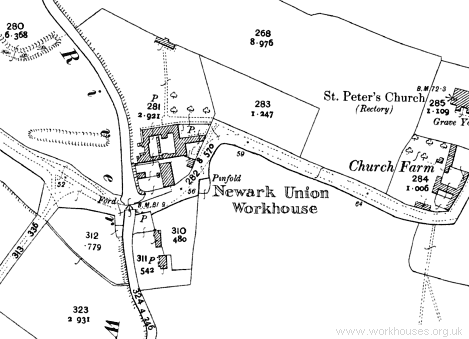
Claypole workhouse site, 1900.
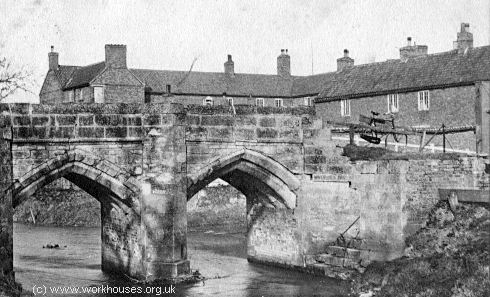
Newark's workhouse at Claypole Bridge.
© Peter Higginbotham.
The building was sold off in 1913 and converted into about twenty cottages. It was demolished in 1978.
The Hawton Road Workhouse
Aged and infirm inmates were housed in the Hawton Road workhouse at Newark. The part of the building containing the town gaol was vacated and a new prison built elsewhere.
Part of the building survives at the rear of a former Castle Brewery.
Bowbridge Lane
In 1878, the Newark Union erected a poor law infirmary and a vagrant ward on Bowbridge Lane in Newark at a cost of £4,000. The building was substantially enlarged in 1908 in a scheme designed by Arthur Marshall of Nottingham. The new buildings adopted the popular pavilion plan layout with a central administrative block flanked by male and female ward pavilions. The original 1878 infirmary was integrated into the new buildings, forming the western ward pavilion. The site layout is shown on the 1915 map below.
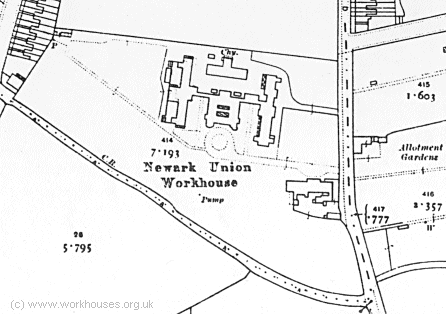
Bowbridge Lane site, 1915.
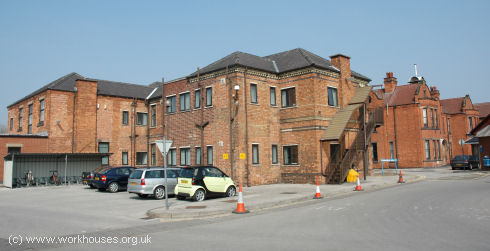
Bowbridge Lane site from the south-west, 2005.
© Peter Higginbotham.
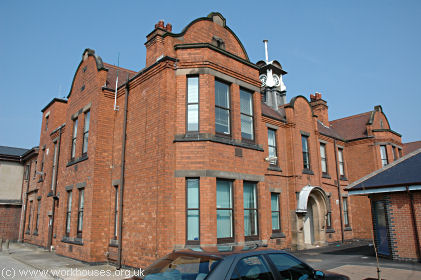
Bowbridge Lane adminstrative block from the south-west, 2005.
© Peter Higginbotham.
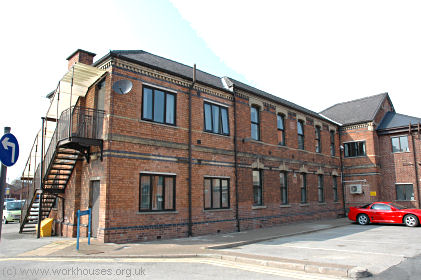
Bowbridge Lane 1878 infirmary block from the south-east, 2005.
© Peter Higginbotham.
After 1948, the workhouse joined the National Health Service as Hawtonville Hospital, later renamed Newark General Hospital.
Cottage Home
The Newark Union established a children's cottage home at Balderton.In 1924, the home could accommodate 20 children, and had Mrs Atkinson as its superintendent.
Staff
Inmates
Records
Note: many repositories impose a closure period of up to 100 years for records identifying individuals. Before travelling a long distance, always check that the records you want to consult will be available.
- Nottinghamshire Archives and Southwell Diocesan Record Office, County House, Castle Meadow Road, Nottingham NG2 1AG. Relatively few records survive — holdings include Guardians' minute books (1836-1930); Register of non-resident poor (1909-13); Vaccination registers (1881-1932); etc.
Bibliography
Links
- None.
Unless otherwise indicated, this page () is copyright Peter Higginbotham. Contents may not be reproduced without permission.


